Roger J. Wendell
Defending 3.8 Billion Years of Organic EvolutionSM


 1. Cotopaxi - 5897m (19,388 ft) |
Ecuador
From Christmastime through January 7th, 2006 CMC leaders |
Note: Not to anyone's surprise, on August 16, 2012, the government of Ecuador granted Julian Assange asylum. For shame.

|
Click Here for our side trips to Amazonia and Quito's New Year's Eve bash! |
Ecuador turned out to be a fascinating, fun-filled adventure I won't soon forget! Despite not speaking Spanish all of the Ecuadorians I met treated me with respect and an even special measure of patience (I got lost a few times, had trouble with restaurant menus, etc.). I found Ecuador to be clean, well organized, and filled with interesting, hardworking people who are very open to Americans and the U.S.While in Ecuador, I learned that their country's national currency, the "Sucre" (named after a very famous General at the time of Simón Bolívar and the war for Independence from Spain [1820-22]), had been discontinued a few years earlier because of rampant inflation and other financial considerations. The government of Ecuador, in place of the Sucre, has officially adopted the U.S. Dollar. This, along with over a million Ecuadorians living and working in the U.S., has closely tied our two countries for the foreseeable future.
With a smile, many Ecuadorians reminded me that New York City is their country's third largest "town" since over 400,000 Ecuadorians live and work there. As a result, sadly, a few hundred Ecuadorians also lost their lives during the 9-11 attacks on the World Trade Center. Anyway, Ecuador is a great place to visit and I hope to return there someday soon to see even more of it!
- Roger J. Wendell
Golden, Colorado - January 2006
Huts and Climbs:
For this particular trip all four climbs were "centered" around the use of mountaineering huts. In our case, the huts were between 15,000 and 16,700 feet but had no electricity or running water (although one had a pay phone!). And, since our tour bus was too big for such steep grades, we usually stopped about a thousand feet below the hut to pack-in our climbing gear, food, and other supplies. Once inside the hut the idea was to go to bed, just after dinner, and then wake up at 10 or 11 pm to start climbing sometime before midnight. The huts are crowded, noisy, and not at all comfortable so getting up just before midnight is easier than you might think! Nevertheless, I, myself, had a horrible time climbing as I was stricken with a mild case of the flu. At about 17,500 feet I was pretty weak and made a U-turn back to the hut and my sleeping bag...
 2. |
 3. |
 4. |
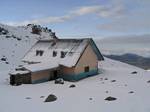 5. |
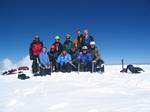 6. (Greg Olson's Photo) |
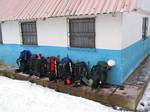 7. |
 8. |
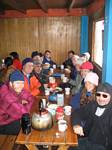 9. |
 10. |
 11. |
 12. |
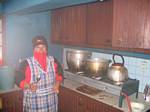 13. |
 14. |
 15. |
 16. |
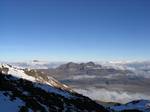 17. |
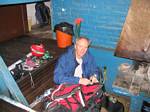 18. |
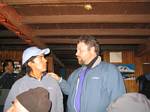 19. |
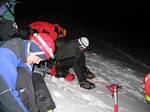 20. |
 21. (Graham Schelle's Photo) |
Food:
Except for a touch of the flu, described above, I had no other illness and enjoyed a variety of food from restaurants and vendors off the street. Although eating from street-vendors is normally discouraged, even in our own country, I enjoy it because it brings me closer to what the local folks normally experience when they're out and about town.
 22. |
 23. |
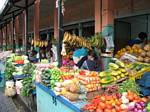 24. |
 25. |
|
 26. |
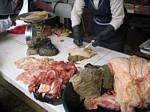 27. |
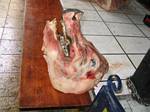 28. |
 29. |
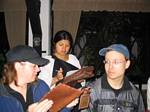 30. |
People and Children:
The best part of any travel! In #39 I was photographing different parts of Baños when this gentleman asked me onto his property to examine his volcanic rock collection! Neither of us spoke a word of the other's language yet we both held a fascination for these fantastic rock samples he had collected from his town's nearby volcano. #36 Is a Photo of Martha and I in front of Quito's Presidential Palace. Although the shot should probably have been placed in my "Quito" section (below) I felt it to be an important "people print" as Martha was so kind to take a good portion of her day to introduce us to not only a most of Quito, but a lot of interesting and colorful people as well!
 31. |
 32. |
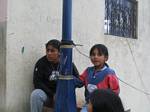 33. |
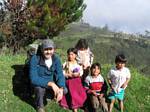 34. |
 35. |
 36. |
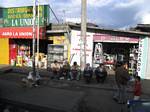 37. |
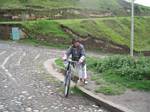 38. |
 39. |
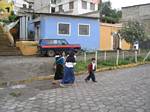 40. |
Quito:
Quito, Ecuador's capitol, sits at about 9,300 feet (2,835 metres) in a long, narrow valley between mountain ranges. Quito boasts most modern conveniences and technology and is home to almost 2 million of Ecuador's nearly 14 million inhabitants. Quito is located just two dozen miles south of the equator but averages a daily temperature of about 70 degrees (Fahrenheit) due to its elevation. As such, there are just two seasons in Quito - the rainy season and the dry season. I have pictures of Quito's New Year's Eve celebration on my Amazonia web page.
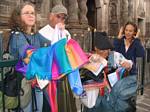 41. |
 42. |
 43. |
 44. |
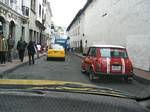 45. |
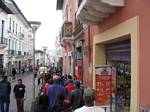 46. |
 47. |
 48. The Equator |
Hacienda San Agustin de Callo:
Our intrepid group made a stop at what is now the San Agustin bed-and-breakfast. Most of the grounds were part of the northern-most section of the Inca empire at the time of Spanish invasions in the 1500s. Original Inca stone and walls house what was later a Spanish religious compound and now the resort. San Augustin's postcard reads, in part, "For centuries, these walls have kept the secrets of astounding cultures, thinkers, scientists, philosophers and artists... Today, these same walls, which were once part of a great Inca temple, will shroud the mystery of your dreams."
 49. |
 50. |
 51. |
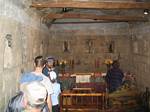 52. |
 53. |
 54. |
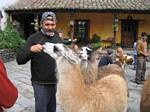 55. |
 56. |
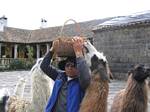 57. |
Miscellaneous Structures:
I found the rebar, sticking out of new and old buildings alike, to be an interesting mystery I'm still not sure the answer of! Found on the corners and main structural points of business buildings and homes I was given a number of reasons for their existence. Some said that it was a tax "device," seen in other parts of South America, that suggests the structure isn't fully complete despite being occupied (hence a lower tax rate). Others said it was a plan for future where there's always the possibility of adding another floor or level by simply utilizing the rebar that's sticking up from below. Some said it was simply a lack of funds, time, or energy that stopped construction. Regardless the reason, there was a "ton" of rebar sticking out of building tops all over Ecuador!Another interesting construction "technique," that I've seen around the continent as well, are the ubiquitous pieces of broken glass sticking out of the tops of walls and building parameters. In inexpensive but apparently effective security barrier...
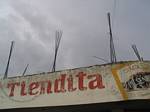 58. |
 59. |
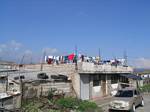 60. |
 61. |
 62. |
 63. |
 64. |
 65. |
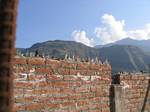 66. |
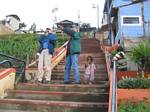 67. |
Ecuador Miscellanea:
Bus rides, beautiful scenery, and great companionship were all part of our trip through Ecuador! On a clinical note, it may be of interest to note that the entire trip cost about $2,500 USD total - a very reasonable price considering it included roundtrip airfare, guide and park fees, in-country transportation, food, lodging (including hut fees as high as $16 per person), and even our side-trip to Amazonia. So, in addition to being very enjoyable, Ecuador was certainly affordable as well!!
 68. |
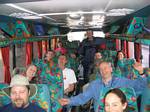 69. |
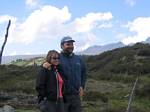 70. |
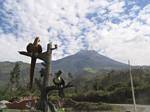 71. |
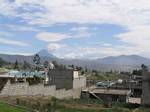 72. |
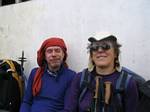 73. |
 74. |
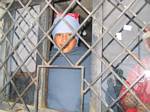 75. |
 76. |
 77. |
Training Day:
Mountaineering, especially along glaciers with crevasse hazards, is a risky business that requires lots of safety training and physical preparation. It's important that team members know how to respond to a variety of emergency situations, especially those requiring that a teammate be pulled up from a crevasse. The CMC, and most of my friends in general, take mountaineering safety and first aid training very seriously. In preparation for Ecuador we all met on a number conditioning and practice climbs that included this crevasse rescue training on St. Mary's Glacier here in Colorado. The session started out on a very cold (and early!) December 17, 2005 morning. Nevertheless, it was a much needed refresher that's needed no matter how much experience climbers may think that have...
 78. Photo by a Snowboarder |
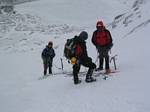 79. Photo by Vernon Bass |
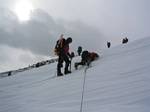 80. Photo by a Vernon Bass |

Links:
|
|
| Warning! Climbing, mountaineering, and backcountry skiing are dangerous and can seriously injure or kill you. By further exploring this web site you acknowledge that the information presented here may be out of date or incorrect, and you agree not to hold the author responsible for any damages, injuries, or death arising from any use of this resource. Please thoroughly investigate any mountain before attempting to climb it, and do not substitute this web site for experience, training, and recognizing your limitations! |

 Back to Roger J. Wendell's Home Page...
Back to Roger J. Wendell's Home Page...
Abbey |
About |
Blog |
Contacting
Me |
Copyright |
Disclaimer |
Donate |
Guest
Book |
Home |
Links |
Site
Index |
Solutions |
Terms,
Conditions
and
Fair
Use |
What's
Changed
or
New?
Copyright
© 1955 -